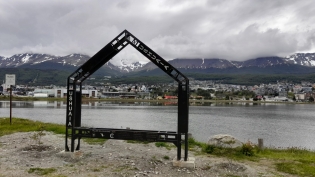Ushuaia-Info | USHpedia | FAQ
What is a tsunami?
A tsunami, a term derived from the Japanese tsu (harbor or bay) and nami (wave), is a complex natural phenomenon involving a train of high-energy waves generated by the vertical displacement of a body of water. Although it is also known as a tidal surge (from the Latin mare, "sea," and motus, "movement"), this term is usually used in regional contexts, while "tsunami" is the internationally recommended technical term.
Origin and Causes
Tsunamis are not caused by atmospheric phenomena such as wind or gravitational forces such as tides, but by extraordinary events that abruptly alter the balance of the ocean. These include underwater earthquakes, volcanic eruptions, landslides, meteorite falls, or even underwater nuclear detonations. According to data, 75% of tsunamis are caused by earthquakes, in which case they are called tectonic tsunamis.
When a tectonic plate shifts violently, the water above it is pushed upward, generating waves that can travel at speeds of up to 800 km/h in deep water, similar to those of a commercial airplane.
Unique Features
Unlike ordinary waves, which affect only the surface, tsunamis involve the movement of the entire water column, from the seafloor to the surface. In the open ocean, their height may be minimal (around 1 meter), but their wavelength can exceed 200 kilometers. This combination allows the tsunami's energy to dissipate little, maintaining its force even after traveling thousands of kilometers.
The Danger on the Coast
The real danger arises when the tsunami approaches coastal areas. As the depth decreases, the wave's speed decreases, but its kinetic energy is transformed into potential energy, causing an abrupt increase in wave height. This effect, known as shallowing amplification, can raise water tens of meters, sweeping away everything in its path.
The total energy released depends on the wave height, its wavelength, and the number of peaks in the wave train. For example, a tsunami may not be a single wave, but rather a series of pulses that arrive minutes or hours later, exacerbating the damage.
Megatsunamis: Extreme Waves
When waves reach exceptional heights (hundreds of meters), they are called megatsunamis. These events are rare and are usually associated with catastrophic landslides or asteroid impacts. One historic case was that of Lituya Bay (Alaska, 1958), where a landslide generated a 524-meter wave, the recorded record.
Consequences and Prevention
The destruction caused by a tsunami is not only due to the direct impact of water, but also to flooding, rip currents, and the accumulation of debris. Understanding their dynamics is crucial for early warning systems and evacuation plans. Technologies such as ocean-floor pressure sensors and simulation models help predict their trajectory and magnitude.
Visitas: 4754
Ushuaia-Info TV
Primavera Cero en Ushuaia | vLog 132Martes 24 de Septiembre de 2024: las nevadas comenzaron pasadas las 10 de la mañana y no se detuvieron.
Un Instante en Ushuaia
 25/11/2025 | 13:59 hs. El marco para llevarse un recuerdo
25/11/2025 | 13:59 hs. El marco para llevarse un recuerdoMás momentos en la ciudad más austral.
Guía de Servicios
Visite la Guía Comercial de Ushuaia-Info, busque los comercios, servicios o productos de su interés.
Farmacias de Turno en Río Grande
Efemérides de Ushuaia
Sucedió un día como hoy en 1928Gunther Plüschow acuatiza con su hidroavión en la BahÃÂa de Ushuaia
 El 5 de diciembre de 1928 acuatizó un hidroavión por primera vez en la bahÃÂa de Ushuaia. El hito fue protagonizado por el capitán retirado de la marina alemana Gunther Plüschow al mando de un Heinkel HD-24.
El 5 de diciembre de 1928 acuatizó un hidroavión por primera vez en la bahÃÂa de Ushuaia. El hito fue protagonizado por el capitán retirado de la marina alemana Gunther Plüschow al mando de un Heinkel HD-24.Próximos días D


